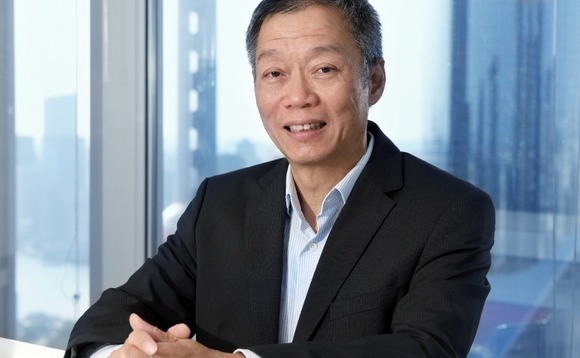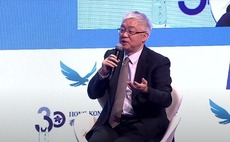
Profile: Qiming Venture Partners' Duane Kuang

Having spent years as an IT advocate in a world obsessed with consumer internet start-ups, Duane Kuang of China-focused Qiming Venture Partners is seeing the tables gradually turn
Duane Kuang began his career in China in the 1990s selling networking equipment to state-owned enterprises that were laying down the country's internet infrastructure. Ten years ago, as an investor in Xiaomi, he was among those who advocated for the introduction of a smart phone that has arguably defined a generation of domestic consumer electronics innovations. Today, Kuang presides over a team that supports start-ups operating at the nexus of artificial intelligence, robotics, and enterprise services.
Just as this resume traces the arc of technological development in China, so Kuang's employment history offers a snapshot of how venture capital investment has evolved. Having built up a book of business as an executive for Cisco, he was recruited by Intel to turn those relationships into deals for its captive VC unit. And when the groundswell of interest in Chinese start-ups was strong enough, he co-founded Qiming Venture Partners, one of the first independent VCs to win Silicon Valley backing.
Though he might claim to have played a significant role within his industry, Kuang is essentially a hardware guy, most passionate when discussing the realization of concepts in material form. He was integral to Qiming's decision to run a separate team for information technology while most other investors bundled it together with consumer internet. He turned that team into an early mover on smart devices and the internet of things (IoT). He might even have persuaded Xiaomi to build a phone.
"I've never asked Lei Jun whether, from day one, he wanted to build a phone. He probably had it in mind, but he didn't have a hardware team, so he was reluctant to commit himself," Kuang says. "When he and his two co-founders presented to Qiming the idea was for a layer on top of the Android OS [operating system] with a user interface to rival the iPhone. During the presentation I said, ‘If the OS is so good, why not do a phone?' He replied, ‘Someday we will, but we'll start with an OS.'"
This was late 2009, approximately two years before Xiaomi launched its debut handset, the MI-ONE, and received 300,000 pre-orders in the first 34 hours. It was five years before the company, having sold more than 61 million phones over the preceding 12 months, briefly became the world's most expensive VC-backed start-up with a valuation of $45 billion. And it was nine years before Xiaomi went public at a market capitalization of $54 billion.
Uncertain about the prospects for a start-up based on an OS alone, the Qiming team prevaricated. Morningside Ventures threw its support behind Xiaomi and provided most of the seed round. Hans Tung, Qiming's deal lead on Xiaomi, was keen enough to invest personally if the firm did not. Qiming ended up contributing $350,000. Several months later, with the OS launched and Lei having secretly recruited a group of engineers from Motorola to start work on a phone, Qiming lead a $10 million round. The investment - a collaborative effort between the consumer internet and IT teams - became one of the firm's most successful investments.
Xiaomi was never pitched as a hardware company. Lei – who made his name as CEO of software developer Kingsoft Corporation and then as sponsor of a string of consumer-facing internet start-ups – always emphasized software and user experience. Hardware was supposed to be a conduit that brought consumers into the Xiaomi ecosystem, not a key profit driver. The difficulties the company faced integrating hardware are familiar to many VC investors raised in the consumer internet space.
"Any time Xiaomi hit a bump it was because of inventory on the hardware side; it was never because the product features were undesirable," says Kuang. "Investing in hardware is different to software and applications. When you procure, there is a lead time. If you don't buy enough and your product is in great demand, you cannot meet that demand. If you buy too much you will have inventory on your hands, and then electronic gadgets fall out of favor very quickly."
Into engineering
As a product of that world, he is well-positioned to judge. Kuang's first job on completing a master's degree in computer science at Stanford University was with 3Com as a software engineer. Rather than follow the same path as his contemporaries and progress through the ranks of multinationals, Kuang decamped to a start-up within three years. He believed he could be more impactful in a smaller corporate environment.
"Three years into 3Com, I felt – wrongly – that I knew a lot. If it didn't work out [at the start-up], I thought that I could land another job. That thinking has carried me through several other changes in my career: I've always been confident in my marketability," he says. "The experience was also helpful in my subsequent VC career. The company had raised money but then ran into some roadblocks and had to lay off close to half the staff and shut several offices. But it survived and thrived."
By 1994, Kuang was looking for a new challenge. He wanted it to be in sales and marketing rather than engineering; and after 14 years in the US, he wanted to return home. Cisco took Kuang on in Hong Kong and then dispatched him to Guangzhou, his home city, as head of southern China. His biggest client was Guangdong Post & Telecom, then China's biggest spender on telecom networking equipment. When Cisco reorganized its business by industry vertical, he was sent to Beijing as telecom lead.
"I was fortunate to witness the construction of the Chinanet backbone, for which Cisco was the primary equipment and technology provider. We also connected most of the large banks in China, from the People's Bank of China to commercial banks like BoC [Bank of China]," he says. "In addition to helping build a lot of the network infrastructure, I got to know many of the first generation of Chinese IT entrepreneurs."
Those entrepreneurs were using the newly laid infrastructure as a platform for their start-ups. A flurry of US IPOs brought in more VC money, which in turn led to Kuang's recruitment by Intel Capital in late 1999. The job description might have been written to fit his profile: they wanted someone US-educated, familiar with China, and proficient in internet networks, though not in investment. The brief was to manage infrastructure projects, specifically find ways in which the firm could replicate its success as an early investor in Hong Kong's PCCW.
These ambitions began to wither as soon as the internet bubble burst and crumbled when the telecom bubble bursting soon after. Kuang was then named head of Intel Capital in China and asked to invest in start-ups. Committing capital from a corporate balance sheet while independent GPs struggled to raise new funds, Intel Capital had its pick of opportunities.
Independent's day
In 2005, the firm made a powerful statement about the importance of China to its overall business by choosing Beijing as the venue for its annual global CEO summit, normally a fixture in California. Kuang served as host and he invited Gary Rieschel to speak. Rieschel was a former colleague at Cisco who had recently left his role running SoftBank's venture capital operation in the US and relocated to Shanghai.
By this point, they were already discussing a potential collaboration. With global VC firms opening offices in China and looking to back local affiliates, there was an appetite for exposure they could satisfy: Kuang would bring the China connections; Rieschel had access to Silicon Valley money. Qiming was established in November 2005 and started pitching LPs on the sidelines of the AVCJ Forum in Hong Kong that month. The first meeting was with the Princeton endowment, the second with Commonfund Capital. Fund I closed on $193 million in January 2006.
"Gary had a longstanding relationship with Ignition Capital in the US from his SoftBank days," says Kuang. "In 2005, anyone who wanted to claim themselves an international shop needed a China strategy. Ignition was therefore very helpful in the launch of our first fund, sharing its rolodex of LPs. There was substantial overlap between our fund and Ignition's funds."
Qiming adopted two characteristics of the US venture capital model that were still a rarity in China at the time. It was structured as an equal partnership with all the managing partners receiving the same compensation. The firm also tried to strike a balance between Silicon Valley-style specialization and the generalist approach prevalent in China. This led to the formation of a dedicated healthcare team, and by Fund II, separate silos for consumer internet and IT.
The consumer internet space took off first – it accounted for 40% of the first few funds versus 20% for IT – as Qiming backed numerous start-ups through multiple funding rounds, culminating in IPOs. The historical portfolio features the likes of online-to-offline services player Meituan-Dianping, photo editing and sharing community Meitu, online entertainment business Taomee, and streaming platform Bilibili.
Meanwhile, the IT team was preoccupied by hardware, chiefly electronic components that were enabling the mobile internet revolution. CooTek is the standout example. It developed the TouchPal smart phone keyboard, which was preinstalled on devices shipped by more than 50 manufacturers last year and had 162 million daily active users. CooTek listed in 2018.
There were other investments in networking infrastructure, content delivery networks, and semiconductor developers, but hardware deals with a consumer element became a key theme in the early and mid-2010s. This coincided with the rise of smart devices globally and the emergence of Xiaomi's ecosystem concept, whereby the company supported IoT start-ups whose products were compatible with its systems and sold through its retail networks.
"We made a number of consumer-oriented hardware investments. This continued up until our last fund with Ubtech Robotics, a company that builds artificial intelligence-enabled humanoid robots that can sing, dance, and do tricks. It's great technology and hard science, but the presentation is a consumer product," says Kuang. "We haven't done many of those of late, however. We decided to take a pause."
A change in focus
Qiming had bulked up in fund size over the years, shifting through the gears from $500 million to $648 million and $935 million for its fourth, fifth and sixth vintages. Healthcare was becoming a more significant, but that pause on consumer-oriented hardware also came as the firm ramped up its exposure to artificial intelligence (AI).
The IT team had started paying more attention to machine learning around 2014 and made investments in areas such as facial and voice recognition and natural language processing. Interest in AI deepened as approaches within the segment became more nuanced. Rather than focus on technologies that could be applied across multiple industries, Qiming was investing in specific verticals like financial services, medical imaging, and industrial automation.
Kuang argues that the China AI debate has moved from basic utility to whether the usefulness of technologies justifies valuations. His takeaway is that solutions that can be put to work immediately and generate value for business customers are inherently more sustainable. Qiming has gravitated towards enterprise software for much the same reason. It led to a significant tweak in investment strategy ahead of raising $1.1 billion for Fund VII earlier this year.
"Towards the end of 2018, we reexamined our strategy. While consumer internet had generated great returns, we felt the market was well developed. Looking forward, given the amount of money required for consumer education, those deals were getting riskier," says Kuang. "We decided to rebalance and shift more of the focus on IT, what people now call 2B."
Consequently, the two technology teams have been reunited, with the distribution of expertise reflecting the changing priorities. There are seven senior executives, three concentrating on consumer internet – Qiming has no plans to vacate the space – and the rest on IT.
As China's VC industry pours more resources into business services, Kuang hopes to find answers to questions he has been asking for 20 years. Prominent among these is when can the country produce a domestic equivalent to Salesforce. He describes enterprise software as "an elusive dream of VCs in China" but claims the ground is shifting. Qiming always tracked the number of software-as-a-service (SaaS) companies with more than RMB100 million ($14 million) in annual subscription revenue; once it hit 10, they knew they would be onto something.
That threshold was crossed two years ago, and many companies now meet these performance criteria. The coronavirus outbreak has helped in this respect, forcing companies to build out IT infrastructure so that employees can work remotely. If the retention rate stays true – it is typically around 90% for SaaS – there will be even more reason for a positive outlook. Chinese enterprise software start-ups also have the chance to prove themselves on a global stage.
"The new breed of big data technology is providing new opportunities for start-ups, many of which are disrupting the world of Oracle and IBM in the US," Kuang says. "Their counterparts in China can do the same because the competition is start-ups that are also relatively new to the space."
Latest News
Asian GPs slow implementation of ESG policies - survey
Asia-based private equity firms are assigning more dedicated resources to environment, social, and governance (ESG) programmes, but policy changes have slowed in the past 12 months, in part due to concerns raised internally and by LPs, according to a...
Singapore fintech start-up LXA gets $10m seed round
New Enterprise Associates (NEA) has led a USD 10m seed round for Singapore’s LXA, a financial technology start-up launched by a former Asia senior executive at The Blackstone Group.
India's InCred announces $60m round, claims unicorn status
Indian non-bank lender InCred Financial Services said it has received INR 5bn (USD 60m) at a valuation of at least USD 1bn from unnamed investors including “a global private equity fund.”
Insight leads $50m round for Australia's Roller
Insight Partners has led a USD 50m round for Australia’s Roller, a venue management software provider specializing in family fun parks.








